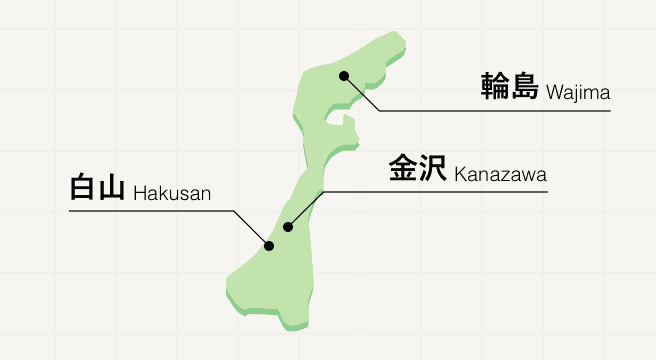Culture / Tour Spots in Wajima Area
Area
-
-
Ishikawa
-
-
Ishikawa

Category


-
- Wajima Museum of Urushi Art (lacquer art museum)
-
4.041 Reviews
- Leisure / Hobbies
- Ishikawa Pref. Wajimashi Mitomorimachi Shijugari 11
- The Wajima Museum of Urushi Art was established in Wajima City, Ishikawa Prefecture as a base for spreading awareness of the region’s outstanding lacquerware-making tradition. The external appearance of the Museum is reminiscent of the Azekura-zukuri (ancient architectural style using interlocking logs with a triangular section) architecture of the Shoso-in treasure house in Nara. Inside the spacious Museum, lacquer is everywhere. Besides displays introducing the historic Wajima lacquer-making tradition, there are also many lacquerware masterpieces made by Living National Treasures and Members of the Japan Art Academy on display. In the adjoining “Urushi no Sato Square”, visitors can view examples of several tree species, including trees that produce lacquer, and other trees the wood of which has lacquer applied to it to make lacquerware.
-
思った以上に素晴らしい。漆を芸術まで高める、それも日常の道具ですでにそうなのだから、流石なのだと思う。しかしそれが今の日常ではないのが残念だ。
-
- Nanso Museum of Arts
-
4.56 Reviews
- Leisure / Hobbies
- Ishikawa Wajima-shi Machinomachi Higashiono
- An art museum located close to the Machino River a 30-minute drive from downtown Wajima City. The museum is housed in a remodeled old rice granary building which has been designated a National Tangible Cultural Property. The museum displays over 250 works of art collected by the Nansoh, a wealthy family which prospered as the hereditary village headmen of imperial lands in the Edo period. Here visitors can see pieces by famous masters, including paintings by the great ink and wash painters Sesshu Toyo and Tawaraya Sotatsu, and pottery by Kyoto potter Ninsei Nonomura. The museum also contains restored areas which reveal what Japanese estates of the time looked like, such as an omoya main residential building and an irori sunken hearth. 400-year-old pines and holly olive as well as Noto Rhododendron obtusum grow in the garden in front of the museum. A Kyoto-style Japanese garden sprawls in the courtyard, and here visitors can take a relaxing stroll while taking pictures of seasonal plants.
-
よくぞこんな辺鄙な場所に大層な美術品が集まっていたなんてと思ってしまいました。美術品に興味のある人なら一度は耳にしたことのある著名人の品々が米蔵を改装した美術館に大した説明もなく並べられています。いずれ、もっとしっかりした方たちによる展示の仕方が変わって行くのでしょうが、ある意味で朴訥で親しみを感じる雰囲気がありました。
-
- Noto Nakai Cast Metal Museum
- Leisure / Hobbies
- Ishikawa Hosu-gun Anamizumachi Nakai Ro 110
- This history museum presents Noto's traditional culture of metal casting. The history of metal casting in Noto is extensive, dating all the way back to the late Heian period according to documents. For the next 800 years, Noto flourished as a center for the production of cast metal items such as shiogama pans used to make salt. Metal casting in the area died out in the modern Taisho period due to the pressure imposed by low-priced metal products from Takaoka. The museum displays examples of locally cast metal items and tools used in metal casting during the area's bygone heyday. There are also ancient documents which illuminate the connections between area metal casters and the Matsugi family, a noble family hereditarily in charge of metal casters across the country.
Ishikawa Areas

Long, thin Ishikawa prefecture runs along the Sea of Japan up into Noto Peninsula. Highlights of the seaside towns lining the west coast include Kanazawa, often described as a "Little Kyoto" thanks to its old wooden tea houses and geisha culture as well as its picturesque Japanese garden, Kenroku-en.
Best of Ishikawa
Search by Region
-
- Hokkaido / Tohoku
- Hokkaido
- Aomori
- Iwate
- Miyagi
- Akita
- Yamagata
- Fukushima
-
- Kanto
- Ibaraki
- Tochigi
- Gunma
- Saitama
- Chiba
- Tokyo
- Kanagawa
-
- Koshinetsu / Hokuriku
- Niigata
- Toyama
- Ishikawa
- Fukui
- Yamanashi
- Nagano
-
- Tokai
- Gifu
- Shizuoka
- Aichi
- Mie
-
- Kinki
- Shiga
- Kyoto
- Osaka
- Hyogo
- Nara
- Wakayama
-
- Chugoku
- Tottori
- Shimane
- Okayama
- Hiroshima
- Yamaguchi
-
- Shikoku
- Tokushima
- Kagawa
- Ehime
- Kochi
-
- Kyushu / Okinawa
- Fukuoka
- Saga
- Nagasaki
- Kumamoto
- Oita
- Miyazaki
- Kagoshima
- Okinawa















